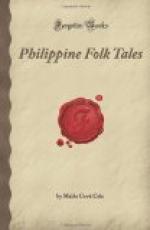[124] This is a good example of the way in which people at a certain stage try to account for their surroundings. Nearly all consider themselves the original people. We find the Bagobo no exception to this. In this tale, which is evidently very old, they account for themselves and their neighbors, and then, to meet present needs, they adapt the story to include the white people whom they have known for not more than two hundred years.
[125] These are evil spirits who have power to injure people. They are ugly to look at and go about eating anything, even dead persons. A young Bagobo described his idea of a buso as follows: “He has a long body, long feet and neck, curly hair, and black face, flat nose, and one big red or yellow eye. He has big feet and fingers, but small arms, and his two big teeth are long and pointed. Like a dog, he goes about eating anything, even dead persons.” Cole, Wild Tribes of Davao District, Field Museum Nat. Hist., Vol. XII, No. 2, p. 107.
[126] This is evidently an old tale in which the story-teller introduces modern ideas.
[127] Here, as is often the case, an origin story has been added to a tale with which it has no logical connection.
[128] This story is well known among the Bilaan, who are one of the tribes least influenced by the Spaniards, and yet it bears so many incidents similar to biblical accounts that there is a strong suggestion of Christian influence. It is possible that these ideas came through the Mohammedan Moro.
[129] The most powerful of the spirits and the one to whom the people resort in times of danger.
[130] A similar story is found in British North Borneo. See Evans, Journal of Royal Anthropological Institute, 1913, p. 423.
[131] Melu, Fiuweigh, Diwata, and Saweigh.
[132] Buswit.
[133] An origin story of a very different type from those of the Bukidnon and Bagobo. While the others show foreign influence, this appears to be typically primitive.
[134] The omen bird of the Mandaya. It is believed to be a messenger from the spirit world which, by its calls, warns the people of danger or promises them success. If the coo of this bird comes from the right side, it is a good sign, but if it is on the left, in back, or in front, it is a bad sign, and the Mandaya knows that he must change his plans.
[135] The crab was called Tambanokano.
[136] An eclipse of the moon. This belief in a monster swallowing the moon and the wild efforts to frighten it away are very widespread. It is found among the Batak of Palawan and in other parts of Malaysia as well as in the South Sea, Mongol, Chinese, Siamese, and Hindoo mythology. Even in Peru we find the belief that an evil spirit in the form of a beast was eating the moon, and that in order to scare it the people shouted and yelled and beat their dogs to make them add to the noise. See Karlson, Journal of Religious Psychology, November, 1914, p. 164.




